Little Girl in a Blue Armchair
| French: Petite fille dans un fauteuil bleu | |
 | |
| Artist | Mary Cassatt |
|---|---|
| Year | 1878 |
| Catalogue | BrCR 56 |
| Medium | Oil on canvas |
| Dimensions | 88 cm × 128.5 cm (35 in × 50.6 in) |
| Location | National Gallery of Art, Washington D.C. |
| Website | Museum page |
Little Girl in a Blue Armchair (French: Petite fille dans un fauteuil bleu) is an 1878 oil painting by the American painter, printmaker, pastelist, and connoisseur Mary Cassatt. It is in the collection of the National Gallery of Art, Washington D.C. Edgar Degas made some changes in the painting.
The Painting
The museum page provenance suggests the painting was possibly shown at the Fourth Impressionist Exhibition 1879 as Portrait de petite fille.[1]
By 1877 Cassatt had come into frank conflict with the official French art establishment and had had both her submissions for that year rejected by the Salon. So when Edgar Degas invited her to join the Impressionists the same year, a group similarly disaffected by the Salon system, she accepted with alacrity.[2] A planned 1878 exhibition did not take place, because of what Degas judged would be competition from the World's Fair held in Paris that year, but she did hold what amounted to a show of her own at the Spring 1879 Impressionist exhibition, exhibiting a dozen oils and pastels. Exactly which works these all were is not now known with certainty, but it is likely that Little Girl in a Blue Armchair was amongst them.[3]
Cassatt submitted the painting to the Art Gallery of the American pavilion at the 1878 World's Fair, along with another that cannot now be identified. To her intense annoyance it was rejected, although the other was accepted.[4] She expressed her irritation in a 1903 letter to the Parisian art dealer Ambroise Vollard, which makes it plain how much Degas had been involved (he also supplied the model, a daughter of friends of his): "It was the portrait of a friend of M. Degas. I had done the child in the armchair and he found it good and advised me on the background and he even worked on it. I sent it to the American section of the big exposition [of 1878], they refused it ... I was furious, all the more so since he had worked on it. At that time this appeared new and the jury consisted of three people of which one was a pharmacist!" [5][6][7] Indeed, the painting is often cited as an example of Degas' influence.[8][9]
Recent cleaning and infra-red photography at the National Gallery of Art has confirmed Degas' contribution.[10]
The painting is described as "it dazzles with its predominant hue of deep turquoise" and has been regarded to be a masterpiece by Karen Rosenberg in a New York Times review.[11]
The dog pictured lying in the armchair next the little girl's in Little Girl in a Blue Armchair is a Brussels Griffon. Cassatt was probably introduced to this breed while in Antwerp 1873. At any rate it was Degas who presented her with a pup he had procured from fellow Impressionist Ludovic-Napoléon Lepic, a dog lover who bred them, and Cassatt went on to keep them the rest of her life.[lower-alpha 1][5][13][14] The painting was purchased from the artist by Amboise Vollard of Paris, and was later acquired by Hector Brame of Paris. It was sold in 1963 to Mr. and Mrs. Paul Mellon. They lent it to the National Gallery of Art for exhibitions and eventually gifted it in 1983 to NGA.[15]
Collaboration with Degas

Cassatt and Degas had a long period of collaboration. Cassatt was introduced to Degas in 1877, probably through the engraver Joseph Tourny, an occasional colleague of the young Degas at the Académie de France à Rome during Degas' three-year study period in Italy. Cassatt met Tourny in 1873 while studying Peter Paul Rubens in Antwerp. Tourny had been sent there on an official commission to copy Rubens' paintings.[16]
Cassatt had known and admired Degas' work since 1875, reminiscing in later life to her friend Louisine Havemeyer "How well I remember nearly forty years ago seeing for the first time Degas' pastels in the window of a picture dealer in the Boulevard Haussmann. I would go there and flatten my nose against that window and absorb all I could of his art. It changed my life. I saw art then as I wanted to see it." [17] Havemeyer repeated the remark at the opening of a 1915 joint exhibition of Cassatt's and Degas' work she had organised in support of women's suffrage.[18][19][20]
The two had studios close together, Cassatt at 19, rue Laval, (48°52′51″N 2°20′18″E / 48.8808°N 2.3384°E), Degas at 4, rue Frochot, (48°52′52″N 2°20′16″E / 48.8811°N 2.3377°E),[21] less than a five-minute stroll apart, and Degas got into the habit of looking in at Cassatt's studio and offering her advice. He also helped her get models, and in particular the girl in Little Girl in a Blue Armchair was a daughter of friends of his.[22]
The American art historian George Shackelford discusses their relationship in his essay Pas de deux: Mary Cassatt and Edgar Degas.[23] John Bullard, lately of the New Orleans Museum of Art, notes that they had much in common: they shared similar tastes in art and literature, came from affluent backgrounds, had studied painting in Italy, and both were independent, never marrying. The degree of intimacy between them cannot be assessed now, as no letters survive, but it is unlikely they were in a relationship given their conservative social backgrounds and strong moral principles. Several of Vincent van Gogh's letters attest Degas' sexual continence.[24] Degas introduced Cassatt to pastel and engraving, both of which Cassatt quickly mastered, while for her part Cassatt was instrumental in helping Degas sell his paintings and promoting his reputation in America.[25] Both regarded themselves as figure painters, and Shacklelford suggests they were influenced by the art critic Louis Edmond Duranty's appeal in his pamphlet The New Painting for a revitalization in figure painting: "Let us take leave of the stylized human body, which is treated like a vase. What we need is the characteristic modern person in his clothes, in the midst of his social surroundings, at home or out in the street." [26][27] These principles are evident in both Cassat's Little Girl in a Blue Armchair and Degas' Portrait After a Costume Ball, painted at the same time. Shackelford goes on to observe that Cassatt's Little Girl in a Blue Armchair shares the same diagonal perspective as Degas' Dance School shown at the same exhibition,[lower-alpha 2] and also features a similar play of light on a back wall.[28] Likewise both paintings crop the image in the manner of the Japanese prints that Degas had introduced Cassatt to.[5]

Cassatt's parents and sister Lydia had joined Cassatt in Paris in 1877, all eventually to share a large apartment on the fifth floor of 13, Avenue Trudaine, (48°52′54″N 2°20′41″E / 48.8816°N 2.3446°E), again close to Degas. Degas became a frequent guest at the Cassatts, and likewise they at his soirées.[29] Degas and Cassatt, accompanied by Cassatt's sister Lydia, were often to be seen at the Louvre studying art works together. Degas produced two prints, notable for their technical innovation, depicting Cassatt at the Louvre looking at art works while Lydia reads a guidebook. These were destined for a prints journal planned by Degas, which never subsequently came to fruition. In addition Cassatt frequently posed for Degas, notably for his millinery series trying on hats. She explained to Louisine Havemeyer that she only posed when his usual models could not get the idea of a particular pose demanded of them.[30] At around this time Degas made a portrait in oils of Cassatt, Mary Cassatt Seated, Holding Cards.[lower-alpha 3] A circa 1880 Self-Portrait by Cassatt depicts her in the identical hat and dress, leading Griselda Pollock to speculate they were executed in a joint painting session in the early years of their acquaintance.[31]
Cassatt and Degas worked most closely together in the fall and winter of 1879–80 when Cassatt was mastering her printmaking technique. Degas owned a small printing press, and by day she worked at his studio using his tools and press while in the evening she made studies for the etching plate the next day. Formerly she had despised drawing, but she now took to carrying a sketch pad with her for the sake of her prints. These sketches were of domestic scenes as well as her theater scenes. Mathews suggests that if Cassatt ever became emotionally attached to Degas in these first few years of their acquaintance, then the theater scenes, with their undercurrent of social intercourse between the sexes, of gallantry and flirtatiousness, may have expressed her feelings.[32] However, in April 1880, Degas abruptly withdrew from the prints journal they had been collaborating on together with Camille Pissarro and others, declaring himself not ready. Without Degas' support the project folded. Degas' withdrawal was entirely in keeping with his fickle and frustrating nature, but it piqued Cassatt who had worked hard at preparing a print, In the Opera Box, in a large edition of fifty impressions, no doubt destined for the journal. Although Cassatt's warm feelings for Degas were to last her entire life, she never again worked with him quite as closely as she had over the prints journal. Mathews notes that she ceased executing her theater scenes at this time.[33]
Illustrations
-

Edgar Degas, Mary Cassatt at the Louvre - The Etruscan Gallery, c. 1879-80, softground etching, drypoint, aquatint, and etching; third state of nine, 26.8 x 23.2 cm, Metropolitan Museum of Art, New York 19.29.2.
-
_c1879-1880.jpg)
Edgar Degas - Mary Cassatt at the Louvre: The Paintings Gallery, c. 1879-80, etching, softground etching, aquatint and drypoint on Blacons wove paper, 30.3 x 12.7 cm, Brooklyn Museum, New York 36.955.
-
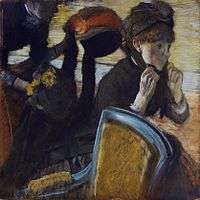
Edgar Degas, At the Milliner's, 1882, pastel on paper mounted on board, 70.2 × 70.5 cm, Metropolitan Museum of Art, New York 141.1957.
-

Mary Cassatt, Drawing of Woman with a Pearl Necklace in a Loge (pencil, 1879), private collection, reproduced in La Vie Moderne (9 August 1879).
-
_-_NGA_1946.21.80.jpg)
Mary Cassatt, c. 1880, In the Opera Box (No. 3), softground etching, aquatint, and etching in black on wove paper, 19.7 x 17.8 cm, National Gallery of Art, Washington D.C. 1946.21.80.
-

Edgar Degas, The Engraver Joseph Tourny, 1857, etching on laid paper, 23 × 14.4 cm, Metropolitan Museum of Art 27.5.5
-
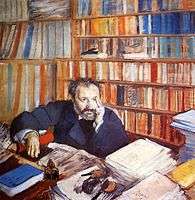
Edgar Degas, Portrait of Edmond Duranty, 1879, pastel and tempera, 100 × 100 cm, Burrell Collection, Glasgow.
-

Edgar Degas, Portrait After a Costume Ball, c. 1877-9, gouache, charcoal, pastel, metallic paint, and oil on canvas, 85.7 x 75.3 cm, Art Institute of Chicago 1954.325.
-
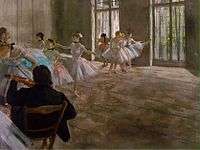
Edgar Degas, Dance School, c. 1876, oil on canvas, 43.8 × 58.4 cm, Shelburne Museum 27.3.1-35a.
-
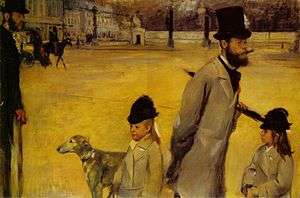
Edgar Degas, Place de la Concorde (Portrait of Ludovic-Napoléon Lepic), c. 1876, oil on canvas, 78.4x117.5 cm, Hermitage Museum 3K 1399.
-

Edgar Degas, Ludovic Lepic Holding His Dog, 1889, pastel, 49.8 × 32.1 cm, Cleveland Museum of Art 1988.93.
-
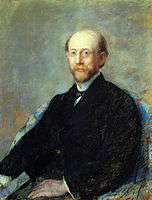
Mary Cassatt, Mr. Moyse Dreyfus, 1879, pastel on tan paper, 80 × 63.5 cm, Musee du Petit Palais, Paris.
Commentaries
Griselda Pollock declares the painting one of the most radical images of childhood of the time.[34] Germaine Greer calls it Cassat's first real stunner: "As an icon of the awfulness of being at once controlled by adults and ignored by them, this bold work could hardly be bettered",[35] a view echoed by Ben Pollitt in his description of the painting as capturing the huffing and puffing tiresomeness that a child feels within the social constraints of an adult world.[9]
John Bullard likens the chairs to bump cars at an amusement park. The portion Degas worked on was probably the oddly-shaped patch of floor between the chairs, as well as the play of light through the windows. The entire painting shows Degas' influence in the asymmetrical composition, the use of pattern, and the cropping of the image in the manner of the Japanese prints he had introduced Cassatt to. He finds the picture an image of the contented boredom of a comfortable bourgeois life, although the slightly languid and provocative pose of the child is disconcerting.[5]
Judith Barter discounts the idea that the jury at the American Pavilion were affronted by the physicality of the girl's pose. A rather similar painting, in terms of the pose, by the Belgian painter Alfred Cluysenaar had been accepted by the Belgian Pavilion. Where they differed was in their treatment, Cluysenaar's being conventional whereas Cassatt's was radical in her handling of the background, and more nuanced in its psychologism. In Clusysenaar's portrait his son holds the viewer in a direct uncomplicated gaze, whereas Cassatt's little girl's gaze is a more elusive sideways glance that asserts her own independence. Cassatt's compelling motivation in her images of children was their care, reflecting the most advanced ideas of the time concerning maternity and the raising of children. The pastel Mother and Child, for example, continues her Degas-like preoccupation with pattern but primarily addresses the strong emotional bond between mother and child.[36]
The painting is referenced in Harriett Chessman's influential 1993 essay Mary Cassatt and the Maternal Body.[37] Extending Griselda Pollock's notion of the "spaces of femininity",[38] Chessman suggests that Cassatt used the child's body in her mother and child paintings as a way of encoding female sexuality.[37] Judith Barter observes that in Cassatt's social millieu the only proper expression of a woman's sexuality was her maternity. In a painting such as Breakfast in Bed we are aware that we have interrupted an intimate moment, but we have not done so improperly. Chessman describes Breakfast in Bed as an allegory of the maternal body.[39][40]
Illustrations
-
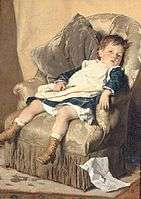
Alfred Cluysenaar, Portrait of the Artist's Son André, 1878, oil on canvas, 111 × 81.5 cm, Royal Museums of Fine Arts of Belgium 2647.
-
.jpg)
Mary Cassatt, Mother and Child (The Goodnight Hug), 1880, pastel on paper, 42 × 61 cm, private collection.
-
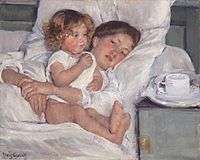
Mary Cassatt, Breakfast in Bed, c. 1897, oil on canvas, 65 × 73.6 cm, Huntington Library.
Notes
- ↑ The pup was probably the one she named Baptiste or "Batty", her constant companion the next decade.[12]
- ↑ In the Degas painting the dancers and floorboards are arranged diagonally, while in the Cassatt painting the chairs are arranged in two diagonal groups. The eye expects movement in diagonal compositions, and this explains much of the curious tension we find in the Cassatt painting (it is of a static scene), and also why John Bullard's liking the chairs to bumps at an amusement park is so strikingly apt.
- ↑ The cards are probably cartes de visite, used by artists and dealers at the time to document their work. Stephanie Strasnick suggests that Degas used them as a device to represent Cassatt as a peer and an artist in her own right, although Cassatt later took an aversion to the portrait and had it sold.[10]
Citations
- ↑ "Little Girl in a Blue Armchair". National Gallery of Art, Washington D.C.
- ↑ Mathews 1994, pp. 98-114.
- ↑ American Paintings: A Catalogue of the Collection of the Metropolitan Museum of Art, Volume 2, p. 632-4, at Google Books
- ↑ Mathews 1994, pp. 131-2.
- 1 2 3 4 Bullard 1972, p. 24.
- ↑ Mathews 1994, pp. 125-6.
- ↑ "Mary Cassatt letter to Ambroise Vollard, ca. 1903". Archives of American Art.
- ↑ "Little Girl in a Blue Armchair". National Gallery of Art, Washington D.C. Archived from the original on 3 December 2013.
- 1 2 "Cassatt's Little Girl in a Blue Armchair". Smarthistory. Archived from the original on 4 December 2013.
- 1 2 Strasnick, Stephanie. "Degas and Cassatt: The Untold Story of Their Artistic Friendship". ARTnews. Archived from the original on 28 March 2014.
- ↑ Friendship Was Their Medium, Degas and Cassatt, Paired at the National Gallery, By KAREN ROSENBERG, MAY, NY Times, 29, 2014
- ↑ Mathews 1994, p. 344 n.14.
- ↑ Mathews 1994, p. 147.
- ↑ "Mary Cassatt was a fellow griffoniac". NYC Brussels Griffon (self-published). Archived from the original on 3 December 2013.
- ↑ "Little Girl in a Blue Armchair". National Gallery of Art, Washington D.C.
- ↑ Shackelford 1998, p. 109.
- ↑ "Louisine Havemeyer on Mary Cassatt, 1927". From Sixteen to Sixty: Memoirs of a Collector. explorepahistory.com. Archived from the original on 23 December 2013. External link in
|publisher=(help) - ↑ Shackelford 1998, p. 140 n.6.
- ↑ Rubinstein 1982, p. 132.
- ↑ Mathews 1994, p. 114.
- ↑ Barter 1998, pp. 354-5 "Mary Cassatt's Paris" (map).
- ↑ Mathews 1994, p. 125.
- ↑ Shackelford 1998.
- ↑ "To Theo van Gogh. Arles, Friday, 4 May 1888". Vincent van Gogh: The Letters. Van Gogh Museum.
- ↑ Bullard 1972, p. 14.
- ↑ Duranty 1990.
- ↑ MoMA Highlights: 350 Works from The Museum of Modern Art, New York, p. 31, at Google Books
- ↑ Shackelford 1998, pp. 113-4.
- ↑ Mathews 1994, pp. 128-31, 147.
- ↑ Bullard 1972, p. 15.
- ↑ Pollock 1998, p. 118.
- ↑ Mathews 1994, pp. 142-7.
- ↑ Mathews 1994, p. 149.
- ↑ Pollock 1998, p. 2129.
- ↑ Greer 2006.
- ↑ Barter 1998, pp. 72-3.
- 1 2 Chessman 1993.
- ↑ Pollock 1998.
- ↑ Barter 1998, p. 73.
- ↑ Chessman 1993, pp. 253-3.
Bibliography
- Barter, Judith A.., ed. (1998). Mary Cassatt, modern woman / organized by Judith A. Barter ; with contributions by Erica E. Hirshler ... [et al.]. New York: Harry N. Abrams, Inc. ISBN 0810940892. LCCN 98007306.
- Breeskin, Adelyn D., ed. (1970). Mary Cassatt: 1844 - 1926. Washington: National Gallery of Art. LCCN 71-133323.
- Bullard, John E. (1972). Mary Cassatt: Oils and Pastels. Watson-Guptill Publications. ISBN 0-8230-0569-0. LCCN 70-190524.
- Chessman, Harriet (1993). "Mary Cassatt and the Maternal Body". In Miller, David C. American Iconology. London: New Haven. pp. 239–58. ISBN 0300054785. LCCN 92046082.
- Duranty, Louis Edmund (1990) [1876]. La Nouvelle peinture : À propos du groupe d'artistes qui expose dans les galeries Durand-Ruel, 1876 (in French). Paris: Echoppe. ISBN 978-2905657374. LCCN 21010788.
- Greer, Germaine (4 January 2006). "Storm in the teacups". The Guardian. Archived from the original on 22 November 2006.
- Mathews, Nancy Mowll (1994). Mary Cassatt: A Life. New York: Villard Books. ISBN 978-0-394-58497-3. LCCN 98-8028.
- Pollock, Griselda (1998). Mary Cassatt: Painter of Modern Women. London: Thames and Hudson. ISBN 978-0-500-20317-0. LCCN 98-60039.
- Pollock, Griselda (2003) [1988]. "Modernity and the spaces of femininity" (PDF). Vision and Difference: Feminism, Femininity and Histories of Art. London: Routledge. ISBN 978-0415308502. LCCN 87030783.
- Rubinstein, Charlotte Streifer (1982). American Women Artists: From the Early Indian Times to Present. Boston: G. K. Hall. ISBN 0816185352. LCCN 81020135.
- Shackelford, George T.M. (1998). "Pas de Deux: Mary Cassatt and Edgar Degas". In Barter, Judith A.. Mary Cassatt, modern woman / organized by Judith A. Barter ; with contributions by Erica E. Hirshler ... [et al.]. New York: Harry N. Abrams, Inc. pp. 109–43. ISBN 0810940892. LCCN 98007306.
External links
- Degas/Cassatt, an upcoming exhibition 11 May - 5 October 2014, at The National Gallery of Art, Washington devoted to the relationship between the two.
- Fourth Impressionist Exhibition works by Mary Cassatt slideshow

